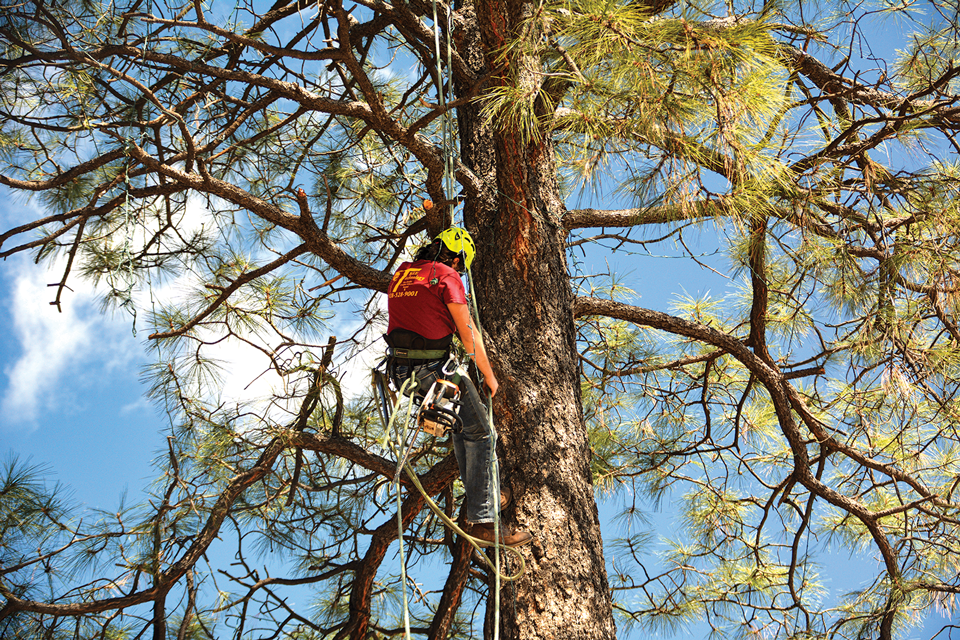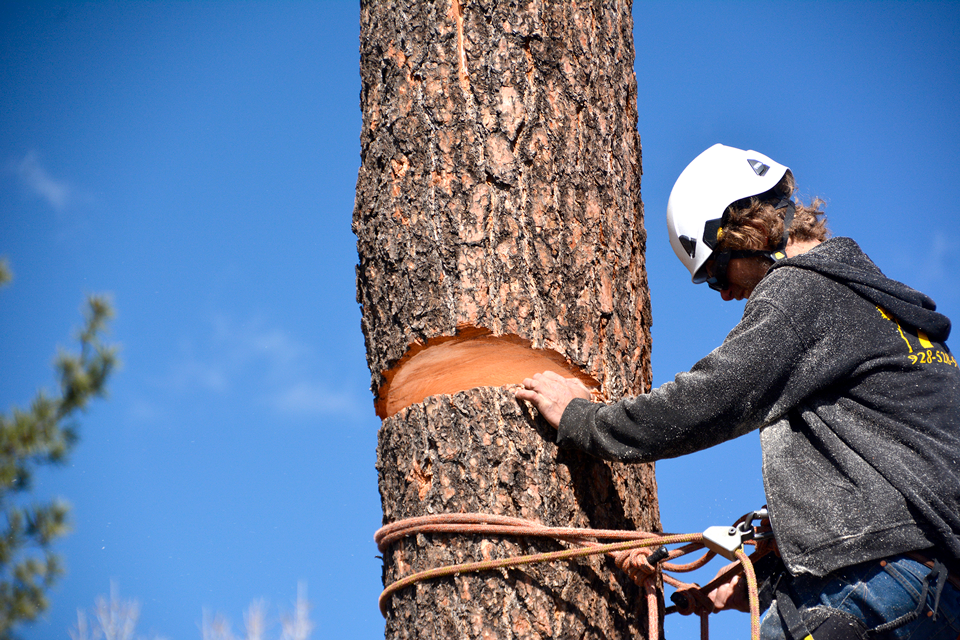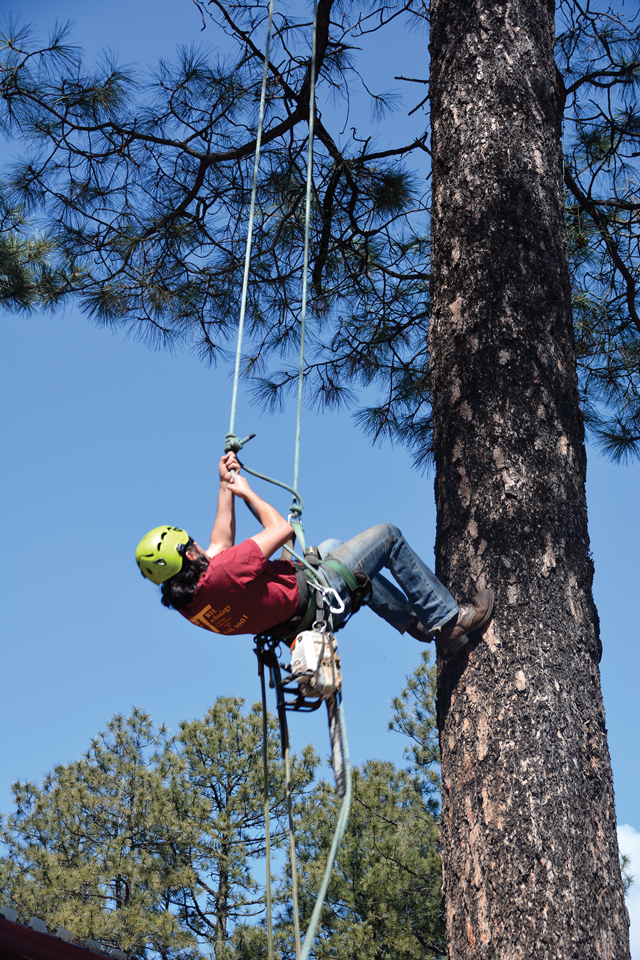A 50-YEAR CAREER DEDICATED TO TREES
About 50 years ago, Ron Kemble started trimming trees. He was offered a job one day as he was walking to a store and the rest is history. He is one of the most trusted and respected arborists on the Mountain and Tree Technology, his 21-year-old business, located in Show Low, uses his decades of knowledge to care for the trees in the White Mountain communities. I met Ron while watching his team cut down a dead tree at Krissie’s Ski and Board in Pinetop and found out that he also has a wealth of information about any tree — and anything pertaining to trees.
Originally from Houston, Texas, Kemble started out clearing power line easements and eventually switched to residential. In fact, he did the pre-construction work for George W. Bush, Senior’s home. He loved Texas and misses some things about the state — except the humidity. Lucky for us, who depend on his expertise when it comes to the health of our trees.
“You can tell the health of a tree pretty easily,” Kemble explained. “You can tell by the color and size of the leaves how it’s growing.” He told me that “trees actually get wrinkles when they get old just like people!” He said that if a tree is split, for example, it more than likely happened when it was very young. It could have been from a deer that may have munched it out or a shoot-tip moth that built its web in it and laid eggs and that part of the tree died. When the tree started growing again, it put two shoots out. It is not considered a limb. “Ponderosa pine trees don’t develop new limbs,” he said. “If you trim them, they won’t grow back.” They grow bigger by adding layer after layer and that is why you see annual rings when you cut a cross section of the tree.”
He told me that a Ponderosa pine would never survive in Texas, just like a Texas loblolly pine wouldn’t survive here. “Ponderosas are a high desert tree and they can live anywhere from 800 to 900 years.” He inferred that we wouldn’t find many that old around here because of all of the logging that has happened here. “I have seen pictures of the logging of giant Ponderosa and they could only fit two sections of the tree on a rail car coming out of the old logging town of Maverick.” He told me that around the Greens Peak area, just past the White Mountain Apache Reservation off of Arizona Route 260, there is a southwestern pine that has a trunk that is about five feet in width and I personally have seen a fir tree in the same area that took 16 people, shoulder to shoulder, to circle the entire width of its trunk.
“The size of the tree has nothing to do with how old it is,” Kemble stated. He has seen a Ponderosa pine four inches in diameter that was over 80 years old and others that were 20 inches in diameter that were only 30 years old. What plays a very important role in a tree’s health is how much nutrition, sunlight and hydration it is getting.
One of the largest trees in the world is an aspen located in Colorado. The tree has a root system that supports thousands of trunks. “We know it is the same tree because of the DNA samples that have been tested,” Kemble clarified. “The oldest trees in the world are located in the Matzatzal Mountains in Arizona — two bristle cone pines — both over 5,000 years old!.”
In the White Mountains and in northern Arizona, there are several types of trees. The oaks you see sprouting up around your yard are called Gamble oaks. They are a very sturdy species in that a wildfire can burn one to the ground and it will sprout back up. Alligator junipers will do the same thing. In fact, if you cut an alligator juniper all the way down to the ground, you could have six to seven trunks grow back.
Alligator juniper only live about 500 to 600 years usually, however, there is one in Prescott (Yavapai County) that has been determined to be over 900 years old and it takes 14 bodies to circle the trunk. It is listed as one of three junipers on The National Register of Champion Trees. The other two are a One Seed juniper and Utah juniper both in Coconino County. The National Registry of Champion Trees started out in 1940 as a competition to locate the largest (and oldest) living specimens of American trees. Today, it protects and preserves these trees for future generations.
I asked Ron his opinion of our surrounding forests and he said that they are in poor health. “It’s not as bad as it used to be,” he said. “The ‘Firewise’ programs have reduced the number of trees per acre.” He said each tree requires a certain amount of nutrients to be able to grow an appropriate amount. “All those trees sharing the same amount of nutrients force them to be happy with less,” he stated. Water plays a very important role in the health of a tree. 65 Ponderosa on an acre can tolerate 16 inches of rain per year but, when you have 500 Ponderosa per acre, 50 inches of rain isn’t enough. “When they don’t get enough water, you end up with four-inch trunks that are 80 years old. The annual rings are so small, you have to sand the cross-cut and stain it just to see them.”
“Ponderosa are supposed to have a nice center on top like a Christmas tree,” Kemble said. “When the top gets damaged and you don’t have an apical center, the tree gets stunted. It may lose its dominant leader and grow two trunks and, if it bunches over, then it is more susceptible to a bark beetle attack.” He told me that there are over 800 types of bark beetles. The IPS beetle attacks trees at a diameter of six inches or less — any height — and you will notice that the tops of the trees are dead. Two other beetles that he mentioned — and are seen in this area — are the Western pine bark beetle that attacks trees up to six inches in diameter and the red turpentine bark beetle that attacks from the ground level to chest high and mostly on trees that have a diameter of 12 inches or more. The beetles can attack all pines such as junipers, piñons, southwestern white pine and southwestern black pine, lodge pole pine, fir and spruce.
Trees can also fall under the attack of fungi, bacterial diseases and viruses and the treatments they receive are similar to how you would treat a person. Unfortunately, for trees, there is not enough research on the illnesses of trees to save some of them. The funding is just not there.
I don’t know about you, but every spring, I feel the pollen from the pines. At least, I thought it all started in spring. Kemble explained to me that, for most people, the pollen from a Ponderosa is too big to cause any allergic reactions. It is smooth and pretty large and is the reason you see so much of it coating your vehicles and anything else that lies beneath its branches. On the other hand, if you could see the pollen from a One seed, alligator and Utah juniper under a microscope, you would see spikes. “It’s similar to the Beetle Juice character when he is bouncing around like a golf ball and he pops out all of his spikes!” Kemble told me. “It gets up into the nasal passages and clings to the hairs in your nose and hangs on — and it all starts in January with the winds and you can see the pollen puff up out of the junipers.” He also said that a good strong breeze can blow the pollen from the cedars all the way from Roosevelt Lake to Show Low.
Ron is teaching his son Jordan to carry on the family business. He is also training him to climb trees competitively, something he missed out on. It’s called the ISA Climbing Championships. However, Ron, a tree climber himself, missed out because they didn’t have the competitions for several years so he became a judge instead. They have held competitions at the Boyce Arboretum, Prescott, Flagstaff and Phoenix. When I asked him if they would ever hold a competition here, he told me that “the only big trees suitable for climbing are Ponderosa and they don’t have a big enough crown.” The tree has to be wide enough so they can ring five different bells. Each bell is a different station and requires something different. A couple of examples are: the limb walk where they walk out on the limb, keeping their weight off of it so it doesn’t bend and sound a buzzer and another station where they have to carry a hand saw while they climb to ring a bell.
I watched Ron’s son, Jordan, climb the giant Ponderosa in front of Krissie’s Ski Shop. I asked Ron if Jordan was ready to compete. He told me he is still developing his skills. From my perspective, which is having my feet securely planted on the ground, it takes a special type of person to scale the incredible heights of a towering Ponderosa and they climb them just about every day.
I told Ron that trees are one of my favorite subjects. “Well,” he said, “we could talk about them until midnight and still have more to talk about.” I’m sure of it. Kemble has a great wealth of knowledge when it comes to his 50-year career of taking care of what I consider to be one of our best national and worldwide treasures…our trees.
















